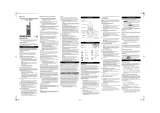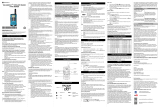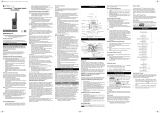
WARNING
WARNING
WARNING
WARNING
Battery Charger Safety Instructions
1. Turn the radio off when charging the battery.
2. Do not expose the charger to outside environment. Chargers
should only be used indoors.
3. Do not operate or disassemble the charger. Do not use a charger
that has been dropped or damaged in any way.
4. Never alter the AC cord or plug provided with the unit. If the plug
will not fit the outlet, have the proper outlet installed by a qualified
electrician. An improper condition can result in a risk of electric
shock.
5. To reduce the risk of damage to the cord or plug, pull the plug
rather than the cord when disconnecting the charger from the AC
receptacle.
6. To reduce the risk of electric shock, unplug the charger from the
outlet before attempting any maintenance or cleaning.
7. Use of an attachment not recommended or sold by specified Solut-
ions may result in a risk of fire, electric shock or personal injury.
8. Make sure the cord is located so it will not be stepped on, tripped
over or subjected to damage or stress.
9. An extension cord should not be used unless absolutely necessary.
Use of an improper extension cord could result in a risk of a fire
and/or electric shock. If an extension cord must be used, make
sure that:
• The pins on the plug of the extension cord are the same number,
size and shape as those on the plug of the charger.
• The extension cord is properly wired and in good condition.
10. The supply cord of the AC adaptor cannot be replaced. If the
cord is damaged, call customer service.
CAUTION
The information listed below provides the user with the information
needed to make him or her aware of RF exposure, and what to do
to as-sure that this radio operates with the FCC RF exposure limits
of this radio.
Electromagnetic Interference/Compatibility
Note: Nearly every electronic device is susceptible to electromag-
netic interference (EMI) if inadequately shielded, designed
or otherwise configured for electromagnetic compatibility.
During transmissions, your radio generates RF energy that
can possibly cause interference with other devices or
systems.
Facilities
To avoid electromagnetic interference and/or compatibility conflicts,
turn off your radio in any facility where posted notices instruct you
to do so. Hospitals or health care facilities may be using equipment
that is sensitive to external RF energy.
Aircraft
When instructed to do so, turn off your radio when onboard an
aircraft. Any use of a radio must be in accordance with applicable
regulations per airline crew instructions.
Medical Devices – Pacemakers, Defibrillators or other Implanted
Medical Devices
WARNING
Persons with pacemakers, Implantable cardioverter
defibrillators (ICDs) or other active implantable
medical devices (AIMD) should
• Consult with their physicians regarding the potential risk of
interference from radio frequency transmitters, such as portable
radios (poorly shielded medical devices may be more susceptible
to interference).
• Turn the radio OFF immediately if there is any reason to suspect
that interference is taking place.
• Do not carry the radio in a chest pocket or near the implantation
site, and carry or use the radio on the opposite side of their body
from the implantable device to minimize the potential for
interference.
Hearing Aids
Some digital wireless radios may interfere with some hearing aids.
In the event of such interference, you may want to consult your
hearing aid manufacturer to discuss alternatives.
Other Medical Devices
If you use any other personal medical device, consult the
manufacturer of your device to determine if it is adequately
shieldedfrom RF energy. Your physician may be able to assist
you in obtaining this information.
Use of Communication Devices While Driving
Always check the laws and regulations on the use of radios in
the areas where you drive.
• Give full attention to driving and to the road.
• Use hands-free operation, if available.
• Pull off the road and park before making or answering a call, if
driving conditions or regulations so require.

















